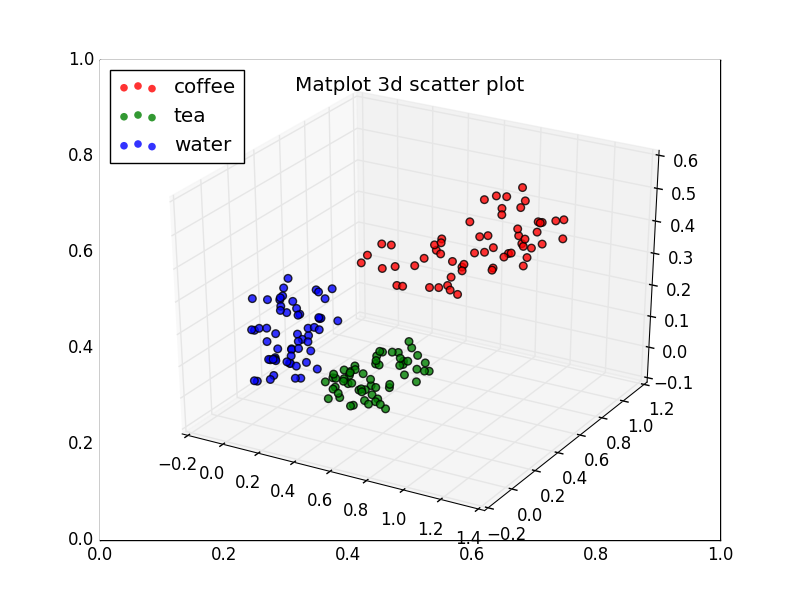

It is important to note here that the data can be classified into several groups. Plt.scatter(x, y, s=area, c=colors, alpha=0.5)
Matplotlib scatter smaller dots code#
Let us create another scatter plot with different random numbers and the code snippet is given below: import numpy as np When you run the above code on your machine you will see the output as shown below: Let us go through the code snippet: import matplotlib.pyplot as plt Simple Scatter Plot Example:īelow we have a code snippet to create a simple scatter plot. Let us dive into some examples and create some scatter plots. This option indicates the blending value, between 0 (transparent) and 1 (opaque). This parameter is used to indicate the marker border-color and also it's default value is None. This parameter indicates the width of the marker border and having None as default value. This optional parameter indicates cmap name with default value equals to None. The default value of this parameter is None and it is also an optional parameter. You can get this scatterplot with Shapely.Here is the code : import matplotlib.pyplot as plt import matplotlib.patches as ptc import numpy as np from shapely.geometry import Point from shapely.ops import cascadedunion n 100 size 0.02 alpha 0.5 def points(): x np.random.uniform(sizen) y np.random.uniform(sizen) return x, y x1, y1 points() x2, y2. As a deprecated feature, None also means 'nothing' when directly constructing a MarkerStyle, but note that there are other contexts where. Extending the solutions by Kyrubas and hwang you can also once define a function scatteredboxplot (and add it as a method to plt.Axes ), such that you can always use scatteredboxplot instead of boxplot: fig, ax plt.subplots (figsize (5, 6)) ax.scatteredboxplot (x np.array ( 1,2,350),np.array ( 1.1,2.2,3.3)) The function. (numsides, 2, angle) An asterisk with numsides sides, rotated by angle. It could be as a single integer value for all data points or as a list of values for individual data points. This parameter allows you to set the size of the markers. (numsides, 1, angle) A star-like symbol with numsides sides, rotated by angle. To change the marker size in matplotlib scatter plots, you can use the scatter () function with the s parameter. This parameter is used to indicate the marker style. A regular polygon with numsides sides, rotated by angle. This parameter indicates the color of sequence and it is an optional parameter with default value equals to None. It is an optional parameter and the default value is None. This parameter indicates the marker size (it can be scalar or array of size equal to the size of x or y). This parameter indicates an array containing y-axis data. To make markers on lines smaller in Matplotlib, we can take the following steps Set the figure size and adjust the padding between and around the subplots. This parameter indicates an array containing x-axis data. Let us discuss the parameters of scatter() method: The syntax to use this method is given below: (x_axis_data, y_axis_data, s, c, marker, cmap, vmin, vmax,alpha,linewidths, edgecolors) The method scatter() in the pyplot module in matplotlib library of Python is mainly used to draw a scatter plot. In 2-Dimensions it is used to compare two variables while in 3-Dimensions it is used to make comparisons in three variables. These plots are mainly used to plot data points on the horizontal and vertical axis in order to show how much one variable is affected by another. Scatter plots make use of dots to represent the relationship between two variables. This plot is mainly used to observe the relationship between the two variables.

The Scatter plot is a type of plot that is used to show the data as a collection of points.
Matplotlib scatter smaller dots how to#
But when I want to add the data, nothing is displayed.In this tutorial, we will cover what is a scatter plot? and how to create a scatter plot to present your data using Matplotlib library. In order to produce a scatter marker of the same size as a plot marker of. When I just scatter the coordinates: m.scatter(x, y,marker='+') it works fine (I have "+" at the corresponding coordinates, i.e on the 75° latitude projected circle). pyplot to be smaller (i.e., the text to be smaller). M.scatter(x, y,marker='+',c=data,cmap=cmap, norm=norm_color,edgecolor='none') M = Basemap(projection='npstere',boundinglat=65,lon_0=310,resolution='l') Norm_color = mpl_colors.Normalize(vmin=None, vmax=None, clip=False)

Here is my code: import numpy as npįrom matplotlib import colors as mpl_colorsįrom mpl_toolkits.basemap import Basemap` I am trying to display these data on a north polar stereographic projected map, but nothing appears on the figure. I have 2 vectors of size 100 of latitudes and longitudes, and a vector 100 of corresponding data of values between 1 and 2. I have some trouble using scatter in python.


 0 kommentar(er)
0 kommentar(er)
